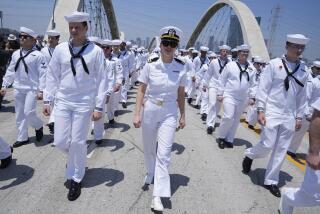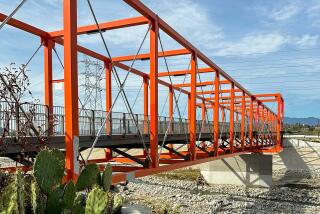Marco Polo Bridge to Be Tourist Attraction : Chinese Spruce Up Landmark of War With Japanese
WANPING, China — An old bridge with 200 stone lions adorning its sides and acclaimed by Marco Polo 700 years ago as a world marvel is being renovated by the Chinese in hope that modern-day travelers will add it to their tours.
It is commonly known as the Marco Polo Bridge because of what the Venetian traveler said about it.
“Over this river there is a very fine stone bridge,” he wrote. “So fine, indeed, that it has very few equals in the world.”
The bridge was completed in 1193 after four years of construction, and Marco Polo crossed it a century later on his travels in China during the 13th Century.
War Landmark
But the bridge is a landmark to the Chinese today for another reason: It is the place where the Chinese-Japanese War began 50 years ago on July 7, 1937, in what is known as the Marco Polo Bridge Incident.
The 740-foot-long bridge’s renovations were made to coincide with the 50th anniversary of the conflict.
Down the street from the bridge, meanwhile, workmen are completing the People’s Anti-Japanese War Museum, a 58,320-square-foot structure to be filled later this year with objects documenting the incident and the ensuing struggle against Japan.
Museum curator Guo Jingxing maintained that the museum is not intended to be anti-Japanese. “Japanese also had casualties and they should remember it as well,” he said.
Bad Timing
But for Japan, the anniversary comes at a particularly bad time, because relations with China are at their shakiest in years. Problems include economic matters and for what the Chinese call Japan’s ambiguous stance toward Taiwan, seat of the rival Nationalist Chinese government.
The Marco Polo Bridge Incident began while Japanese troops were on maneuvers near the bridge, 12 miles west of Beijing and adjacent to the last rail route into the city not controlled by Japan.
(The Japanese had been in northern China since their victory in the 1905 Russo-Japanese War.)
The Japanese, claiming that one of their soldiers was missing, tried to enter Wanping to look for him but were resisted by Chinese troops.
Three-Day Battle
The battle, involving about 3,000 men, went on for three days, with Japan failing to take Wanping. Before talks on settling the dispute were completed, Japan’s Kwangtung Army poured troops southward through the Great Wall, and reinforcements were sent to north China from Japan.
By the end of July, Beijing and Tianjin in the north were in Japanese hands. By October, Japan had overrun Shanghai after bloody street fighting. And in December, Japanese troops entered the fallen Nationalist capital of Nanking.
In the next eight years, before the Allied victory in the Pacific in August, 1945, more than 1.3 million Chinese died in battle against Japan. Millions more died of disease, hunger and other consequences of war.
Among the trickle of recent tourists to the bridge, however, are many Japanese. Zhang Fenfu, a 36-year-old local photographer whose grandmother witnessed the bridge incident, said that Japanese visitors, particularly young ones, bear no ill-feelings.
Tourist Attraction
“The Japanese who have come in recent years have expressed friendship, and there is no anti-Japanese sentiment (among Chinese),” Fenfu said.
The local district, which has received 20 million yuan ($5.4 million) for the museum and 4 million yuan ($1.1 million) to restore the bridge, is hoping to turn the bridge into a major tourist attraction.
There are plans for forest areas, hotels, an old-style village and even a race track in the next decade.
The bridge’s 11 arches now span a dry Yongding River, which flooded in 1698 and seriously damaged it.
More to Read
Sign up for The Wild
We’ll help you find the best places to hike, bike and run, as well as the perfect silent spots for meditation and yoga.
You may occasionally receive promotional content from the Los Angeles Times.






